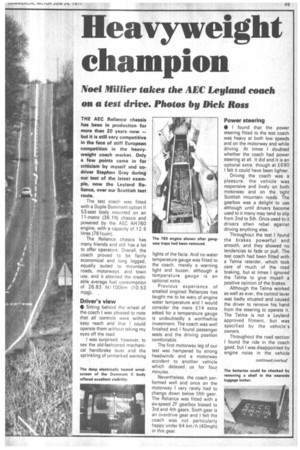Heavyweight champion
Page 51

If you've noticed an error in this article please click here to report it so we can fix it.
Noel Miltier takes the AEC Leyland coach on a test drive. Photos by Dick Ross
THE AEC Reliance chassis has been in production for more than 20 years now — but it is still very competitive in the face of stiff European competition in the heavyweight coach market. Only a few points came in for criticism by myself and codriver Stephen Gray during our test of the latest example, now the Leyland Reliance, over our Scottish test route.
The test coach was fitted with a Duple Dominant option II 53-seat body mounted on an 11-metre (36.1 ft) chassis and powered by the AEC AH760 engine, with a capacity of 12.5 litres (761cuin), The Reliance chassis has many friends and still has a lot to offer operators. Overall, the coach proved to be fairly economical and long legged, equally suited to mountain roads, motorways, and town use, and it attained the creditable average fuel consumption of 26.83 lit/100krn (10.53
T111)9) , Driver's view
• Sitting behind the wheel of the coach I was pleased to note that all controls were within easy reach and that I could operate them without taking my eyes off the road.
I was surprised, however, to see the old-fashioned mechanical handbrake lever and the sprinkling of unmarked warning lights of the facia. And no water temperature gauge was fitted to the coach, merely a warning light and buzzer, although a temperature gauge is an optional extra.
Previous experience of smalled engined Reliances has taught me to be wary of engine water temperature and I would consider the mere £14 extra asked for a temperature gauge is undoubtedly a worthwhile investment. The coach was well finished and I found passenger seats and the driving position comfortable.
The first motorway leg of our test was hampered by strong headwinds and a motorway accident to another vehicle which delayed us for four minutes.
Nevertheless, the coach performed well and once on the motorway I very rarely had to change down below fifth gear. The Reliance was fitted with a six-speed ZF gearbox biased to 3rd and 4th gears. Sixth gear is an overdrive gear and I felt the coach was not particularly happy under 64 km/h (40mph) in this gear.
Power steering
• I found that the power steering fitted to the test coach was heavy at both low speeds and on the motorway and while driving. At times I doubted whether the coach had power steering at all. It did and it is an optional extra, though at £690 I felt it could have been lighter.
Driving the coach was a pleasure: the vehicle was responsive and lively on both motorway and on the tight Scottish mountain roads. The gearbox was a delight to use although until drivers become used to it many may tend to slip from 2nd to 5th. Once used to it drivers often rebel against driving anything else.
Throughout the test I found the brakes powedul and smooth, and they showed no tendencies to fade or pull. The test coach had been fitted with a Telma retarder, which took care of much of the road braking, but at times I ignored the Telma to give myself a positive opinion of the brakes.
Although the Telma worked as well as ever, the control lever was badly situated and caused the driver to remove his hand from the steering to operate it. The Telma is not a Leyland approved fitment, but was specified by the vehicle's owners.
Throughout the road section I found the ride in the coach good, but I was disappointed by engine noise in the vehicle
continued overleaf




































































































